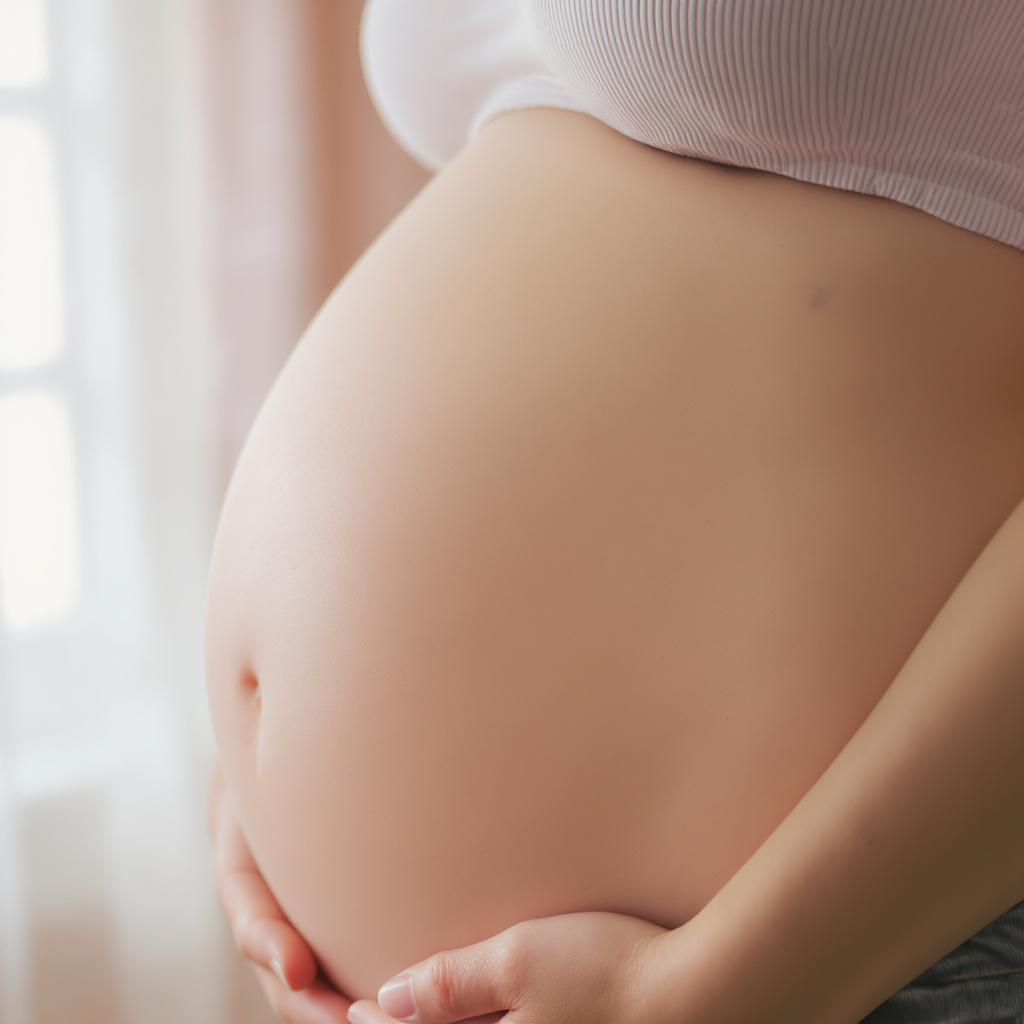As you embark on the journey of motherhood, your body undergoes a series of remarkable transformations to support and care for your newborn. Among these changes is postpartum swelling, a common occurrence that many new mothers experience. Understanding why this happens can help alleviate any worries you might have.
Postpartum swelling, or edema, generally affects the legs, feet, and hands. This condition often surprises new moms, but it's a natural response your body has to the big event of childbirth. During pregnancy, your body produces approximately 50% more blood and bodily fluids to meet the needs of your growing baby. After giving birth, your body begins to readjust by eliminating the excess fluids, leading to swelling.
Why does this swelling occur, and how can you manage it? Several factors contribute to postpartum swelling. The excess fluids mentioned are just one part of the story. During labor, IV fluids are frequently administered, which can also lead to increased fluid retention. Additionally, the hormonal shifts that helped your body prepare for childbirth will gradually stabilize over a few weeks. All these changes create a feeling of being slightly puffier than usual. It's important to remember that this is a temporary phase. With time and some simple self-care practices, this swelling will naturally reduce.
- Engage in gentle movement, such as walking, which can help improve circulation and assist your body in flushing out excess fluids.
- Elevate your feet whenever possible to reduce swelling in the legs and feet. Rest your feet on a cushion even during short breaks throughout the day.
- Stay hydrated. Drinking plenty of water actually helps your body shed the accumulated fluids.
- Adopt a balanced diet rich in essential nutrients. Include foods that are high in potassium, such as bananas and spinach, to assist in reducing fluid retention.
It can be frustrating to deal with postpartum swelling, but knowing that it's a typical part of the recovery process may ease your concern. Many women find comfort in sharing their experiences with other new mothers, discovering that they are not alone on this path. Always tune into your body’s signals, and if something doesn’t feel right, seek advice from a healthcare professional.
Nurturing yourself is crucial during this phase. Embrace the practice of self-care with openness and patience, keeping in mind that each day, your body is healing and adapting to its new rhythm. This period, filled with moments of awe and learning, will pave the way to rediscovering your strength and resilience as you nurture your little one.
The phenomenon of edema during and after pregnancy can be attributed largely to fluid retention, an essential process designed by nature to aid both the mother and her unborn baby. During pregnancy, the body retains extra water to support the developing life within and to prepare for blood loss during delivery. This fluid build-up, however, can lead to noticeable swelling in various parts of the body post-birth.
Moreover, the role of hormonal changes, particularly the increase in hormones like progesterone and estrogen, cannot be understated when examining postpartum swelling. These hormones are critical in preparing the body for childbirth but can also cause blood vessels to dilate, resulting in increased fluid retention.
Another contributing factor to swelling is the surge in blood volume that occurs during pregnancy. According to research, a woman's blood volume increases by about 50% to nourish the growing fetus and prepare for labor's physical demands. This increased blood volume, although necessary, contributes to the puffiness and edema experienced postpartum.
Various lifestyle aspects, such as cesarean deliveries, can also influence the extent of postpartum edema. A C-section involves surgical incisions and may require administration of additional fluids, potentially exacerbating fluid retention. Similarly, the level of physical activity during and after pregnancy plays a significant role. Regular, gentle exercises like walking are encouraged as they promote circulation and minimize swelling.
Dietary habits before and after childbirth can also impact the degree of swelling experienced. Consuming a nutritious, balanced diet with less sodium and high potassium foods can be particularly beneficial in managing fluid retention. According to nutritional guidelines, potassium helps balance the levels of sodium in the body, aiding in the overall reduction of edema.
Understanding these processes provides a sense of control, empowering you to manage your postpartum experience with knowledge and practical tips. As each mother and her journey are unique, patience with oneself is paramount. Throughout this period, recognizing the incredible work your body has done fosters a deep sense of appreciation. It's not just about reaching a certain endpoint; it's about embracing your newfound strength and nurturing this bond that will only grow with time.
As new mothers settle into their postpartum routine, it's common to notice swelling, especially in the legs and feet. This is where fluid tends to accumulate due to gravity, making these areas particularly prone to edema. Interestingly, hands are also frequent sites for swelling, often prompting women to temporarily set aside rings until their fingers return to a more familiar size. Though this puffiness can be disconcerting, understanding its typical nature is reassuring.
Recognizing the signs that signify normal postpartum swelling can help ease your mind. It's usually symmetrical, meaning both feet, ankles, and hands swell evenly. The skin might feel tight but will usually resume its normal contours upon gentle pressing, leaving a slight indentation that quickly fades. The swelling gradually improves with rest, elevation, and hydration, naturally decreasing over the first few postpartum weeks.
However, there are instances where swelling could indicate something more concerning. If you notice sudden swelling in one limb, especially when accompanied by pain or redness, it could signify a blood clot, requiring immediate medical attention. Severe or persistent swelling, especially in combination with symptoms like headaches or blurred vision, could be a sign of preeclampsia. These scenarios necessitate prompt consultation with healthcare providers to ensure safety and well-being.
In moments of uncertainty, reach out to your healthcare provider for guidance. A brief conversation can provide clarity and peace of mind, especially when something feels off or unfamiliar. Regular postpartum check-ups are vital, as they offer an opportunity to discuss any concerns, including those related to swelling and recovery.
Remember, this period is as much about nurturing yourself as it is about caring for your newborn. In doing so, you create a balanced environment that benefits both you and your baby. With empathy and understanding, you can gently find your footing amidst these changes, fortified by the knowledge that every day brings new strength and familiarity.
The gentle embrace of rest cannot be overstated during this precious postpartum period. Prioritizing rest is essential for your body as it undertakes the remarkable process of recovery and healing. Elevating your legs whenever you can, even during brief moments of peace, is highly beneficial. This simple act aids in reducing swelling by promoting circulation and counteracting gravity's pull, particularly effective when reclining with your feet supported on a cushion.
Though it may seem counterintuitive, staying well-hydrated is key to reducing fluid retention. Drinking adequate water encourages your body to release the excess fluids it no longer needs. Think of hydration as a gentle detox, smoothly priming your system to find its equilibrium again. Each sip is a small step towards feeling more yourself.
Nourishing your body with the right foods during this time can also ease the postpartum transition. Focus on incorporating foods rich in potassium, such as bananas, sweet potatoes, and avocados, as they help balance sodium levels and alleviate fluid retention. At the same time, moderate your sodium intake. Opt for fresh foods over processed ones, favoring natural flavors that support your well-being without the added salt.
Embrace brief, gentle physical activities, like walking, to further enhance your postpartum recovery. These small movements bolster circulation and assist in gradually dissipating the accumulated fluids. Even a leisurely stroll with your baby can offer benefits, fortifying your body while nurturing a precious connection with your little one.
Throughout this journey, remember the immense strength embedded within you. The extraordinary work your body does daily deserves the utmost care and acknowledgment. As you navigate this new chapter, with all its unique rhythms and discoveries, trust that you are adapting beautifully. Gradually, as days glide into weeks, the swelling will recede, unveiling the resilient spirit that resides within. Cherish each gentle step forward, knowing you are supported by both knowledge and the shared experience of countless other mothers who have traveled this path before you.
Incorporating the soothing properties of cold compresses can offer much-needed relief from postpartum swelling. Gently applying a cool compress to the affected areas, particularly the legs and feet, helps to constrict blood vessels, providing a calming sensation that can ease discomfort during those tender moments of recovery. This straightforward technique serves as a gentle reminder of the power of simplicity in your postpartum care routine, inviting a moment of serene self-care amidst the bustling new rhythm of motherhood.
Moreover, the art of massage becomes a tender tool in alleviating swelling and enhancing your postpartum experience. Through gentle strokes and soft pressure, massage encourages circulation, assisting your body in redistributing accumulated fluids. This nurturing touch not only addresses physical discomfort but also offers a moment of reconnection with your body, fostering a sense of well-being that transcends the physical benefits. By integrating massage into your routine, either self-administered or with the help of a partner, you create an opportunity for relaxation and rejuvenation, contributing to a holistic recovery process.
For sustained management of swelling, consider the supportive embrace of compression stockings. These specialized garments are designed to apply consistent pressure to your legs, aiding in the efficient return of blood flow and reducing the retention of fluids. As they gently hug your calves and ankles, compression stockings work quietly to maintain comfort and mobility throughout the day, making them a valuable ally in your postpartum toolkit. Opt for a well-fitted pair to ensure effectiveness, consulting with a healthcare provider if needed, to ensure you select the right level of compression tailored to your needs.
These gentle interventions, rich with nurturing intent, form a tapestry of care that complements the body's natural healing journey. As you navigate this new chapter, each thoughtful action taken to soothe and support your body reinforces the profound strength within you. Embracing these practices allows both body and spirit to find equilibrium, empowering you to step forward with grace and confidence into the beautiful unfolding of motherhood.
Amidst the physical transformations that accompany motherhood, the emotional effects can be equally significant. Swelling and other changes might alter how you perceive your body, but it's essential to remember the incredible feats it has accomplished. Such perceptions can evoke a mix of emotions, from admiration to apprehension, but they are all normal and part of the postpartum tapestry.
In these times of transition, embracing self-compassion can be profoundly healing. Your body is a testament to strength, nurturing life and adapting daily to new challenges. Cultivating a positive body image starts with acknowledging this inner resilience. Engage in dialogues with yourself that reinforce appreciation and acceptance. Simple affirmations of gratitude for what your body has achieved can nurture a nurturing mindset.
- Speak to yourself with kindness, recognizing the powerful journey your body has embarked upon.
- Acknowledge the emotions that arise without judgment, creating space for healing and acceptance.
Sharing these experiences with loved ones and community can further enhance your emotional well-being. Surrounding yourself with understanding family members, friends, or joining support groups can foster a shared sense of solidarity. Knowing others are navigating the same waters can alleviate feelings of isolation and bolster emotional comfort.
These support systems offer a nurturing environment where voices of shared wisdom and empathy uplift you. In moments of doubt or heightened emotions, reaching out can provide reassurance, reminding you that you are not alone in this chapter of life.
As you continue to adapt, each day offers an opportunity to strengthen the bond with your growing network of support. Whether seeking advice, sharing a laugh, or simply being present, these interactions weave a fabric of resilience and love around you and your child. Together, these elements contribute to a holistic postpartum experience, one that honors both your physical and emotional journey.
The path of motherhood, with its myriad of transitions, invites a compassionate exploration of self. By nurturing both body and spirit amid these changes, you cultivate a harmonious environment that embraces the fullness of this new reality. Trust in the empowering cycle of self-care, support, and self-love, paving the way for a journey marked by grace and resilience.
As you navigate through postpartum recovery, it is vital to recognize when to seek medical advice to ensure a safe and healthy transition for both you and your child. While minor swelling and discomfort are expected during this time, certain symptoms require more diligent attention. Empower yourself by understanding these clear indicators, emphasizing the importance of proactive healthcare.
- Severe or Unrelenting Pain: If you experience intense pain that doesn't subside with rest or over-the-counter medications, it's crucial to contact your healthcare provider. This could be a sign of inflammation or an underlying condition that needs prompt evaluation.
- Sudden or Asymmetrical Swelling: Noticeable differences in swelling between limbs or a rapid increase in puffiness should not be ignored. Sudden swelling, especially when accompanied by redness or tenderness, could indicate conditions like deep vein thrombosis.
- Addition of Other Symptoms: If swelling is accompanied by symptoms such as headaches, vision changes, or high blood pressure, there could be a risk of more serious conditions. These symptoms warrant immediate medical consultation to rule out preeclampsia or other complications.
Establishing a regular routine of check-ins with your healthcare provider is essential to tailor postpartum care to your specific needs. Each mother's experience is unique, and an individualized assessment ensures that your recovery optimally supports your health and well-being.
During these check-ups, open communication with your healthcare professional can provide assurance and guidance. Share any concerns, even those that might feel minor, to receive comprehensive support. These visits serve as a foundation, not just for monitoring physical milestones, but also for reinforcing your emotional well-being.
Embrace these moments as opportunities to strengthen your healthcare alliance, one rooted in understanding and trust. This collaboration not only addresses immediate concerns but also empowers you with knowledge and confidence, nurturing your journey through motherhood and beyond.
In the quiet moments of reflection, acknowledge the strength and resilience that have guided you through this journey so far. Continue honoring your body's needs and trusting in the vibrant community that supports you, ensuring both you and your newborn thrive in the nurturing environment you've created together.
In the rich tapestry of motherhood, recognizing and celebrating the resilience of new mothers becomes a profound affirmation of their incredible journey. Each day, as you guide your newborn through their first experiences in the world, you are simultaneously navigating the multifaceted changes within your own body. This remarkable ability to adapt, nurture, and thrive deserves admiration and acknowledgment.
The temporary nature of postpartum swelling is a gentle reminder that these physical adjustments are part of a transient phase. Your body, having performed the awe-inspiring work of nurturing life, is now returning to its own equilibrium. Understanding that this swelling will subside over time is crucial, offering solace and patience in moments where change feels overwhelming. Rest assured, this phase is a transition, not a permanence.
Throughout this transformative time, prioritizing self-care and understanding is essential. Imagine this phase as a beautiful dance between healing and newfound responsibilities, where grace and flexibility become key. Embrace self-care not as a luxury, but as a fundamental part of your journey. This nurturing practice extends beyond physical recovery; it is about cultivating a compassionate space where you can meet your evolving needs with kindness.
Engaging in activities that bring joy and relaxation is a vital part of this holistic approach. Whether it’s taking quiet moments for reflection, nourishing your body with wholesome foods, or reaching out to supportive networks of friends and family, every act of self-care adds to your well-being. By weaving these moments into your day, you bolster your capacity to care for both yourself and your little one, creating a balanced environment ripe for growth and connection.
As you navigate this newly charted territory, remember that each challenge met is a testament to your unwavering spirit. The path of motherhood is paved with varied experiences, each offering insights that strengthen and illuminate your journey. In these reflections, find pride and joy, and know that your resilience is a beacon, lighting the way forward for both you and your child.
This powerful journey you are on, rich with learning and grace, serves as a bridge between what was and what now is. Hold this narrative close, and find comfort in the shared experiences of mothers around you. Trust in this gradual unfolding, and carry forward with the knowledge that every step you take is filled with purpose and promise, for yourself and for the new life you cherish.


















